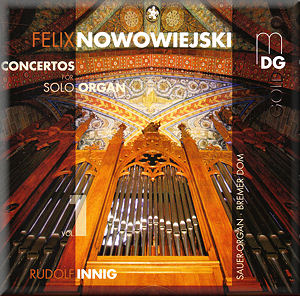 |
 |
|


alternatively
CD: MDT
AmazonUK
AmazonUS
|
Feliks NOWOWIEJSKI (1877-1946)
Concertos for solo organ – Vol. 1
Entry into the Cathedral (Festive March), Op. 8/3 (date unknown)
[3:21]
Concert for organ, Op, 56/1 (1938-1941) [31:16]
Pieces for organ, Op. 9 (unknown)
I. Prelude on Roses of St. Theresa, Op. 9/2 [3:54]
II. Prelude on a theme Kyrie from Mass No. 11, Op. 9/3 [5:48]
III. Introduction to the chorale Salve Regina, Op. 9/4 [3:13]
IV. Introduction to the sequence Victimae paschali laude, Op. 9/7
[4:25]
V. Introduction to the hymn Veni Creator, Op. 9/8 [4:06]
Concerto for Organ in A major, Op. 56 No 2 (1938-1941) [23:04]
 Rudolf Innig (organ)
Rudolf Innig (organ)
rec. 23-24 January 2009, Bremen Cathedral, Bremen, Germany
 MUSIKPRODUKTION DABRINGHAUS UND GRIMM MDG 317-1591-2 [79:42]
MUSIKPRODUKTION DABRINGHAUS UND GRIMM MDG 317-1591-2 [79:42]

|
|
|
A distinct advantage of smaller labels is that they tend to
explore the repertoire the majors overlook. MDG are a case in
point, especially with their enterprising Organ Landscape series
– see my review
of the Lithuanian instalment – and their collection of works
for organ and choir by Jan Janca – review.
Part of the latter was played on the great Sauer organ of Bremen
Cathedral, the instrument used on this Nowowiejski disc. The
organist Rudolf Innig is new to me, although I see his discography
includes the organ works of such diverse composers as Brahms
and Messiaen.
I suspect the Polish composer, conductor, concert organist and
music teacher Feliks Nowowiejski is also unfamiliar to all but
the most dedicated organ buffs. Among his compositions are several
operas and choral pieces, but his main interest seems to have
been the organ, for which he wrote six symphonies (Op. 45) and
four concertos (Op. 56). Two of the latter – Nos. 1 and 2 –
are recorded here. But first, the undated Entry into the
Cathedral (Festive March); it’s a magisterial piece, yet
the central section is more delicately scored. The recording
is deep and wide, with no muddying of detail, and Innig plays
with commendable restraint and dignity. An excellent introduction
to this collection and a piece I’d be happy to revisit.
The Op. 9 organ pieces – of which Nos. 5 and 6 are lost – are
based on chorales and Polish hymns. The solemn cadences of No.
2, ‘Prelude on Roses of St. Theresa’, are splendidly done, although
it soon becomes clear that Nowowiejski’s sound world is rather
short on transparency and general lightness of touch. That said,
there are some lovely rhythms here, and the movement ends in
a mood of genuine serenity. The third prelude – based on the
Kyrie from one of the composer’s Mass settings – strikes me
as bluff and forbidding, akin to Sibelius but without the colour,
thrill and momentum one hears in the latter’s splendid pieces
for organ. The remaining three pieces, based on a chorale, a
sequence and a hymn, are accomplished enough – No. 4 is more
colourful than the rest – but they are just too unvarying to
hold one’s ear for long.
The first of the Op. 56 concertos is a somewhat lugubrious affair,
the opening ‘Veni creator’ emerging slowly from a dark cistern
into the bright light of day. There is some marvellous pedal
work here and moments of sustained ecstasy that may well remind
listeners of early Messiaen. As for textures, they are remarkably
dense, the material intensively worked; indeed, the effect is
almost improvisatory at times. The Sauer organ is certainly
a splendid instrument, but one senses that weight and overall
shape matter more in this music than colour or nuance. By contrast,
the second movement, ‘Infantes Dei’, has a lovely melodic line,
although Nowowiejski really does seem to favour dark, bass-led
sonorities. As for the final movement, ‘Epilogue: In Paradisum’,
anyone looking for a hint of Messiaenic radiance will be sorely
disappointed. No epiphanies here, I’m afraid.
The second concerto isn’t much different, although the opening
salvoes of the first movement really demonstrate the Sauer’s
heft. But for all its virtuosity there’s a rather dry aspect
to this music, its gargle and roar apt to become a tad wearying
after a while. That said, even at its blustery extremes the
MDG engineers manage to maintain the organ’s focus and clarity,
the ancient, well-worn melodies of the ‘Canon Grègorien’ especially
well caught and played. There’s a welcome leavening of mood
and texture here, but then Nowowiejski retreats into imperiousness
in the concluding ‘Toccata’. As required there is a lightness
of touch in parts, but on the whole it’s just too inscrutable
for my tastes.
I suppose if one had to characterise Nowowiejski’s idiom it
would have to be a rather pedagogic focus on the music’s rigorous
inner workings and general architecture at the expense of instrumental
colour and harmonic variety. The effect is not unpleasing, but
some listeners may find the composer’s musical persona – and
the Sauer sound – much too stern and joyless for comfort. As
with the music, the liner-notes are just as earnest and uninspiring.
So, apart from a memorable curtain-raiser there’s little here
I would care to revisit; still, MDG must be applauded for taking
risks with repertoire most labels wouldn’t touch. No doubt there
are still some gems to be unearthed, but you won’t find any
here.
Dan Morgan
|
|

